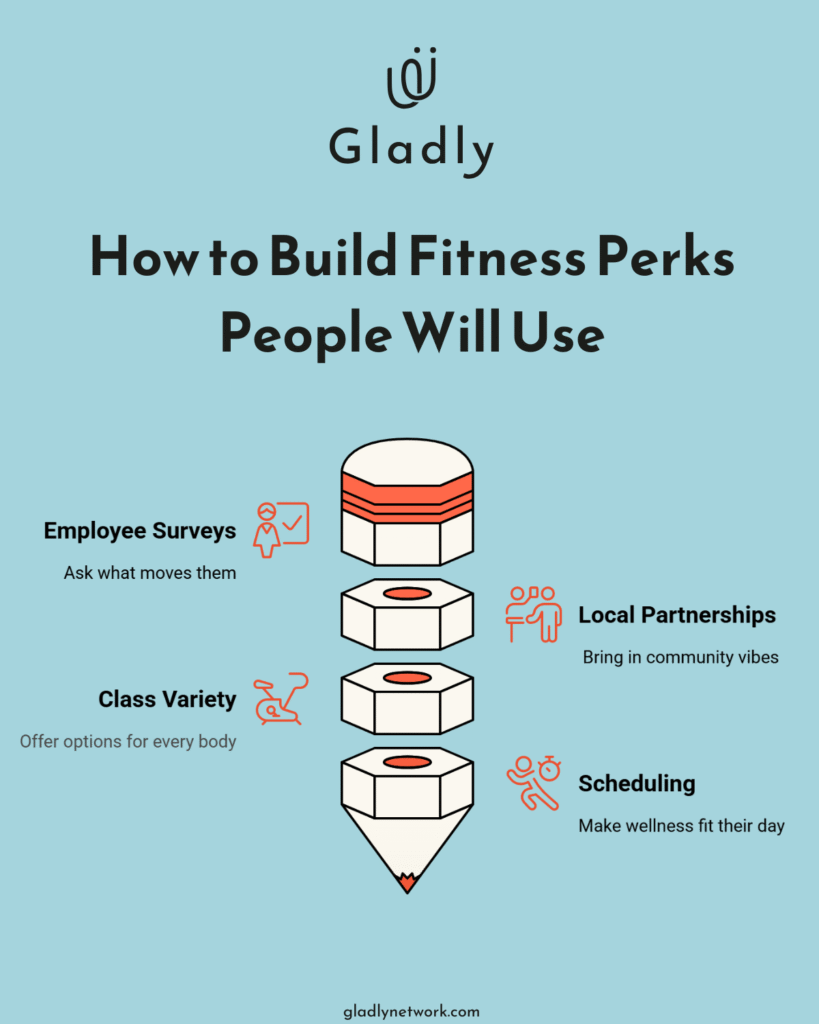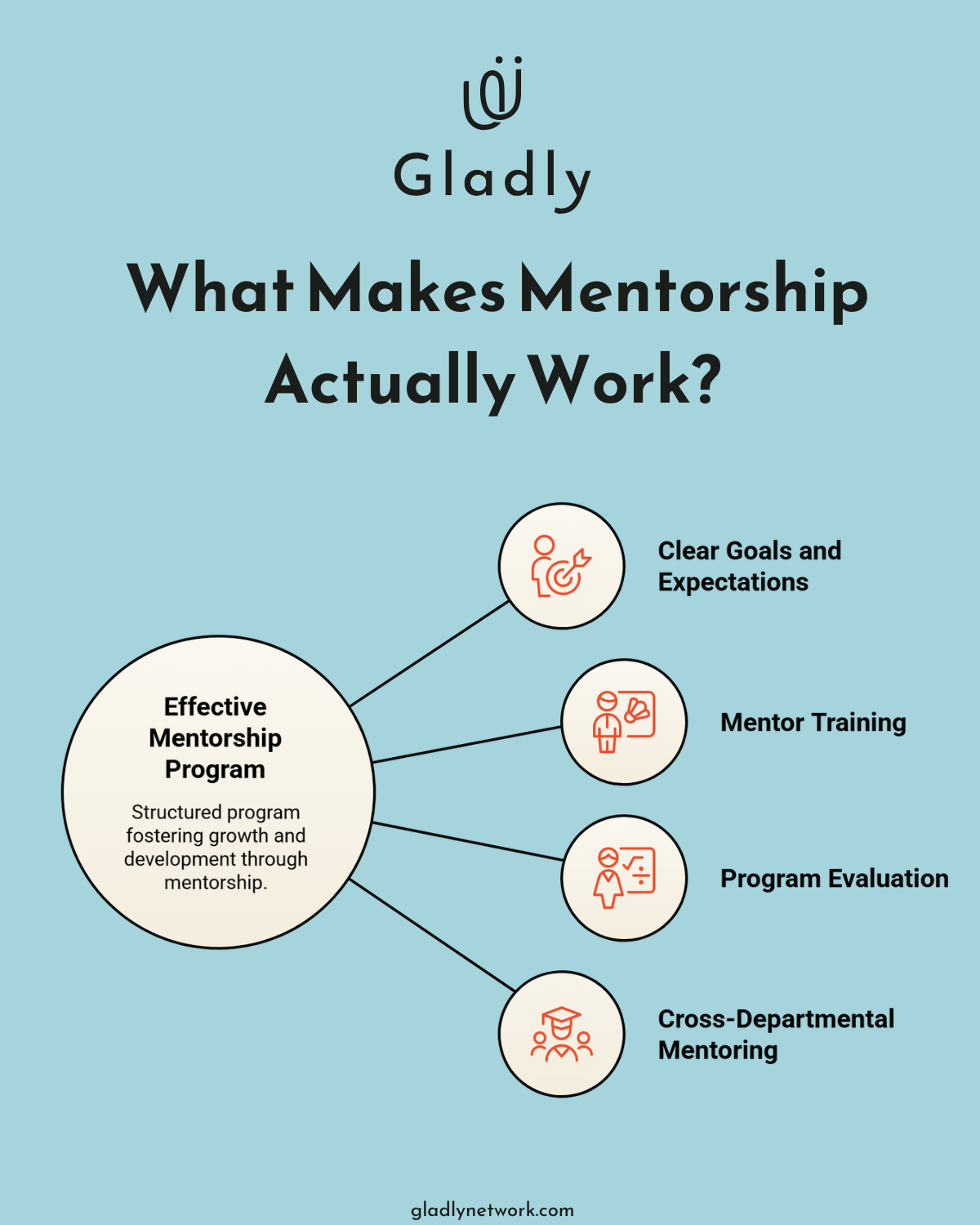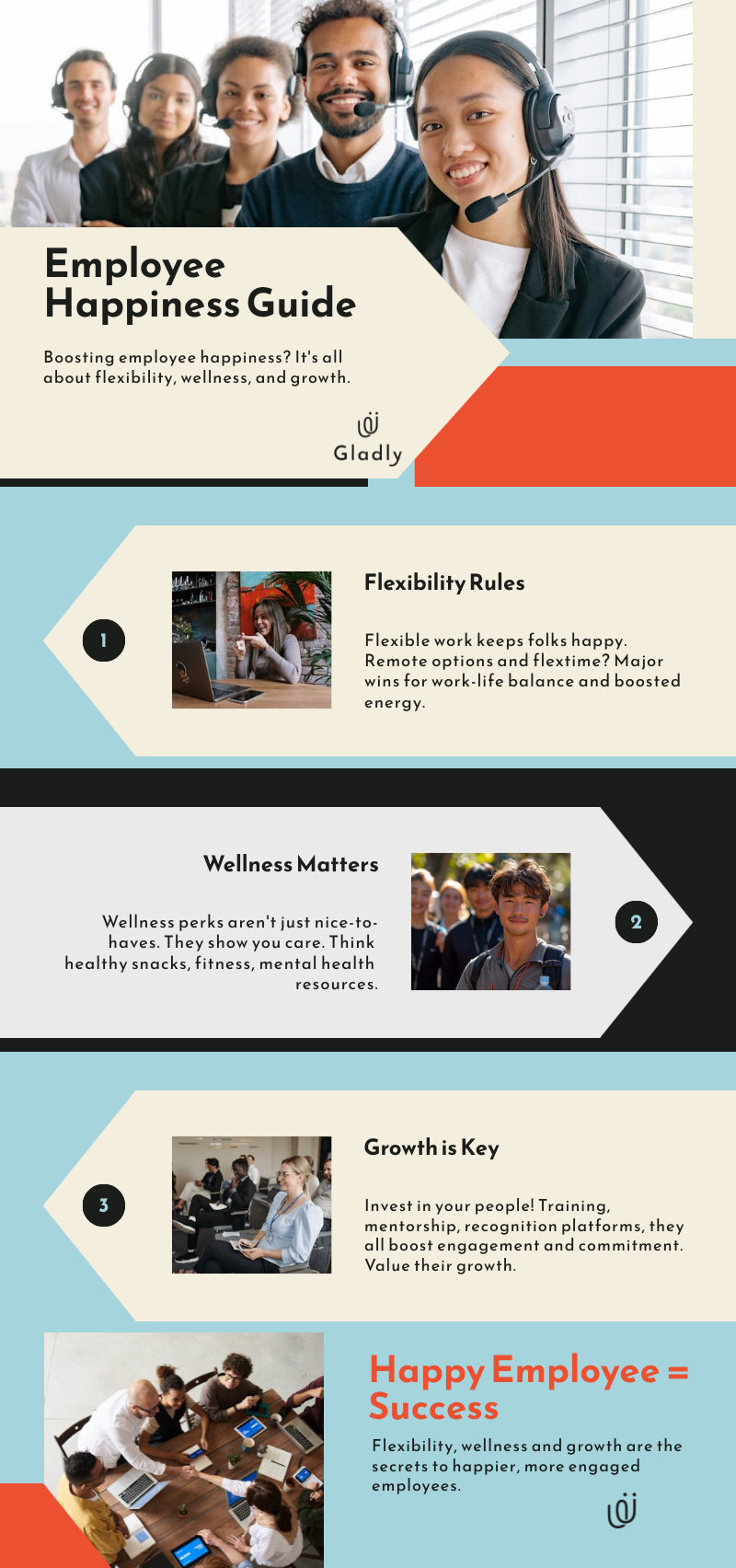Employee perks are a powerful tool for attracting and retaining top talent. At Gladly Network, we believe that happy employees are the foundation of any successful company.
In this post, we explore creative benefits that improve satisfaction, increase engagement, and promote long-term productivity by putting people first.
How Flexible Work Arrangements Boost Employee Satisfaction
Remote Work: The New Normal
At Gladly Network, we’ve witnessed the transformative power of flexible work arrangements on workplace satisfaction. Companies that embrace flexibility often experience a significant increase in employee morale and productivity. Let’s explore effective ways to implement flexible work options that benefit both employees and employers.
Remote work has surged in popularity, especially since the COVID-19 pandemic. Half of remote workers report feeling more energized (48 percent) than last year, compared to 21 percent who report feeling burnt out. This statistic underscores the importance of offering remote work options to attract and retain top talent.

To implement successful remote work policies, companies should:
- Invest in reliable communication tools (e.g., Slack or Microsoft Teams)
- Establish clear expectations for work hours and availability
- Provide necessary equipment or stipends for home office setups
- Schedule regular virtual team-building activities to maintain company culture
Flexible Hours: Empowering Employees
Flexible hours allow employees to adjust their work schedules to better fit their personal lives. This can lead to improved work-life balance and increased job satisfaction. A workplace study found that 63% of the happiest employees say they are able to telecommute, work flextime, or both.
To implement flexible hours effectively:
- Define core hours when all employees must be available
- Use time-tracking software to ensure accountability
- Encourage open communication about scheduling needs
- Regularly review and adjust policies based on team feedback
Alternative Work Schedules
Companies can also consider offering alternative work schedules like compressed workweeks or job sharing. A compressed workweek involves working longer hours on fewer days, while job sharing allows two part-time employees to share the responsibilities of one full-time position.
These options can particularly benefit employees with caregiving responsibilities or those pursuing further education. The Bureau of Labor Statistics reports that about 10% of full-time wage and salary workers had alternative work schedules in 2019.
When implementing alternative schedules:
- Clearly outline expectations and responsibilities
- Ensure proper coverage during business hours
- Regularly assess the impact on team productivity and collaboration
- Be open to adjusting policies based on employee feedback and business needs
As we move forward, it’s essential to consider how these flexible work arrangements can complement other employee perks. Let’s explore how companies can promote health and wellness initiatives to further enhance employee satisfaction and productivity.
How Health and Wellness Initiatives Transform Your Workplace
At Gladly, we believe wellness should be accessible. Our platform reflects that. It’s free and allows companies to give their teams easy access to services that support daily health, balance, and motivation. Employees can explore benefits that align with their real needs and personal values, including access to ethical lifestyle brands that promote everyday well-being.
Let’s take a closer look at the initiatives that can truly transform the workplace.
Fitness Programs That Energize Employees
On-site fitness classes have become a popular perk. About 80% of U.S. businesses with more than 50 employees offer wellness programs to help their staff stay healthy and happy. These classes promote physical health and foster team bonding and stress relief.

To implement successful on-site fitness programs:
- Survey employees to determine preferred class types
- Partner with local fitness instructors or gyms
- Offer a variety of classes to cater to different fitness levels
- Schedule classes during lunch breaks or immediately after work hours
For companies unable to provide on-site facilities, subsidized gym memberships can be an excellent alternative. Nearly half (51%) of employers offer some form of fitness center subsidy. This perk allows employees to choose their preferred gym and workout schedule, which promotes a more personalized approach to fitness.
Mental Health Support: A Critical Workplace Component
Mental health support programs have become increasingly important. Globally, an estimated 12 billion working days are lost every year to depression and anxiety at a cost of US$1 trillion per year in lost productivity. Companies that implement robust mental health support can significantly impact employee well-being and company performance.
Effective mental health initiatives might include:
- Employee Assistance Programs (EAPs) that offer confidential counseling services
- Regular workshops on stress management and mindfulness
- Mental health days as part of paid time off policies
- Training for managers to recognize and support employees’ mental health needs
Mental health support thrives when backed by accessible, ongoing resources. Platforms like ImpactSuite offer a modern approach to workplace wellness by combining self-guided tools, emotional check-ins, and access to professional care.
These kinds of solutions help normalize conversations around mental health while giving employees flexible ways to manage stress and build resilience, at work and beyond.
Nutrition: The Fuel for Productivity
Providing healthy snack options in the office is a simple yet effective way to promote employee wellness. For remote and hybrid teams, discounted nutrition plans through partners like NiTOR can offer a flexible, accessible alternative.
A study by Peapod found that 66% of employees who have access to free food at work are “extremely” or “very” happy with their current job.
To implement a successful healthy snack program:
- Stock a variety of nutritious options (e.g., fresh fruits, nuts, whole grain snacks)
- Consider dietary restrictions and preferences
- Rotate offerings to maintain interest
- Educate employees on the benefits of healthy eating habits
Wellness Challenges: Engaging Employees in Health Initiatives
Wellness challenges can motivate employees to adopt healthier lifestyles while fostering a sense of community in the workplace. These challenges can range from step-counting competitions to healthy eating contests.
To create effective wellness challenges:
- Set clear goals and rules for the challenge
- Use technology (such as fitness trackers or apps) to track progress
- Offer incentives or rewards for participation and achievement
- Encourage team-based challenges to promote collaboration
As companies continue to prioritize employee health and wellness, the next logical step is to invest in their professional growth and development. Let’s explore how organizations can create opportunities for their employees to learn, grow, and advance in their careers.
How to Invest in Your Employees’ Growth
Employee development is essential for individual and organizational success. Professional growth opportunities enhance skills, boost job satisfaction, and improve retention rates. Let’s explore effective ways to support your employees’ career advancement.
Tuition Reimbursement Programs
Tuition reimbursement attracts and retains top talent. Data reveals that while 80% of working adults are interested in going to school, only 40% know their employer offers a tuition reimbursement program. These programs show a company’s commitment to long-term employee growth.
To implement an effective tuition reimbursement program:
- Set clear eligibility criteria and reimbursement limits
- Align the program with your company’s skills and needs
- Require a minimum tenure post-completion to ensure return on investment
- Offer guidance on relevant courses and institutions
Conference and Industry Event Participation
Supporting employee attendance at conferences and industry events keeps your team updated on the latest trends and innovations. It also provides networking opportunities that benefit both the individual and the company.
To maximize the value of conference attendance:
- Establish a fair selection process for attendees
- Set clear expectations for knowledge sharing post-event
- Ask employees to present their learnings to the team
- Consider hosting internal mini-conferences to spread knowledge
Mentorship and Coaching Initiatives
Mentorship programs significantly impact employee growth and satisfaction. Retention rates were much higher for mentees (72%) and mentors (69%) than for employees who did not participate in the mentoring program (49%).

To create an effective mentorship program:
- Define clear goals and expectations for both mentors and mentees
- Provide training for mentors on effective coaching techniques
- Regularly evaluate the program’s impact and adjust as needed
- Consider cross-departmental mentoring to broaden perspectives
Creating a culture where growth and recognition go hand in hand can transform how employees show up every day.
While formal training and mentorship programs offer essential structure, many teams also benefit from tools that make appreciation and feedback part of everyday interactions. Platforms like Motivosity make it easier to build that culture by encouraging peer-to-peer recognition, empowering managers with real-time insights, and helping teams stay connected, especially in hybrid or flexible environments.
When employees feel both seen and supported, personal development becomes a shared journey, not just a checkbox.
Skill-Building Workshops and Training
Regular skill-building workshops and training sessions keep employees engaged and help them stay current in their fields. LinkedIn’s 2019 Workplace Learning Report states that 94% of employees would stay at a company longer if it invested in their learning and development.
To implement impactful training programs:
- Conduct regular skills gap analyses to identify training needs
- Offer a mix of technical and soft skills training
- Utilize both internal experts and external trainers
- Implement a learning management system to track progress and completion
These professional development opportunities create a culture of continuous learning and growth. This benefits individual employees and contributes to the overall success and innovation of the organization.
Explore Purposeful Perks That Make a Real Impact
Creative employee perks can do more than boost morale; they can shape a culture of care, loyalty, and lasting impact. The most effective perks reflect what your team truly values, aligning well-being, flexibility, and growth with your company’s purpose.

At Gladly Network, we make it easy to turn those values into action. You can explore exclusive, feel-good perks that support both your employees and the greater good. Whether you’re offering wellness boosts, ethical products, or unique rewards, each item in our marketplace helps you create a workplace people feel proud to be part of.
Signing up is free, and every purchase is a step toward doing good, at work and beyond. We can build a culture where purpose and perks go hand in hand.











